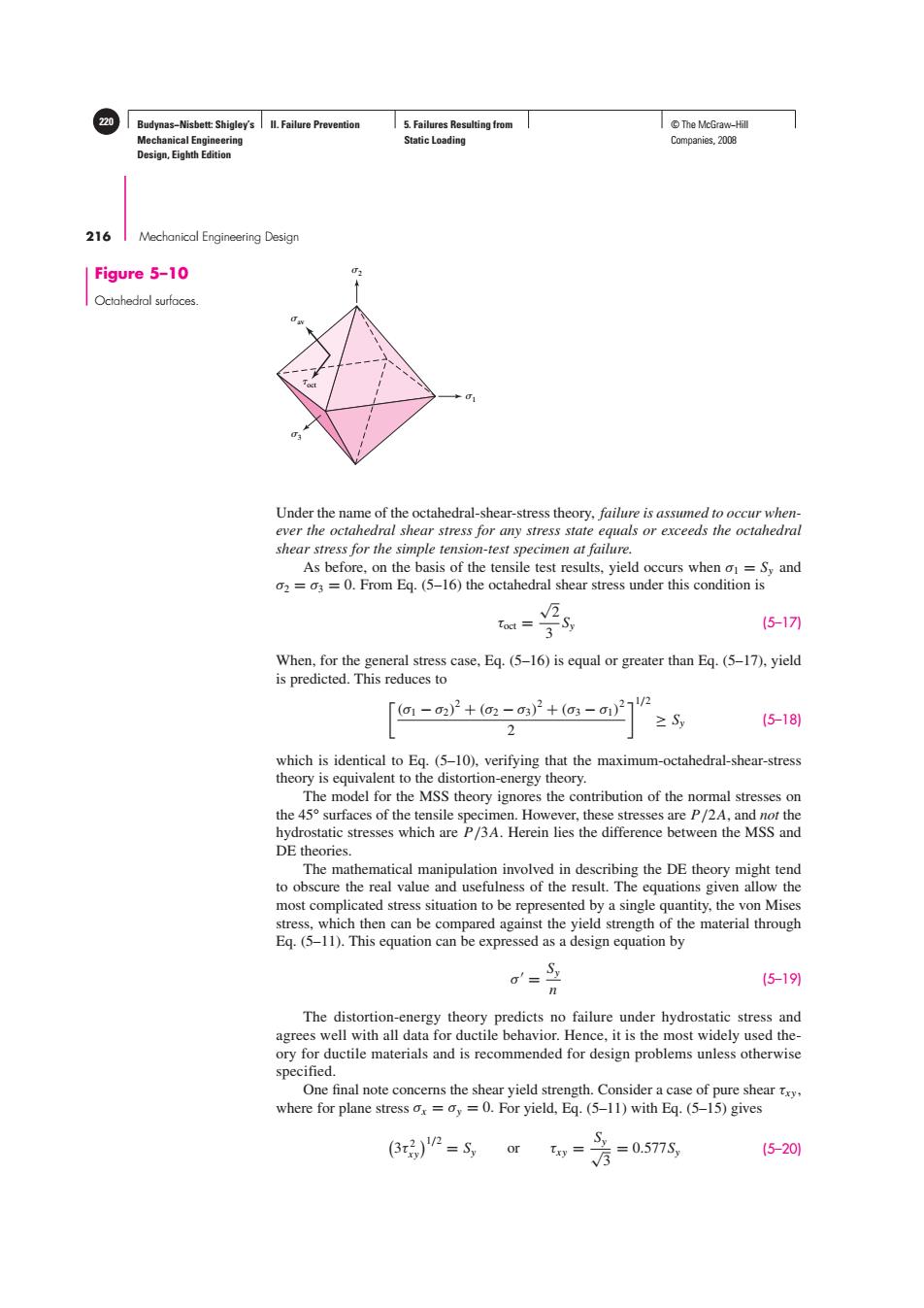正在加载图片...

20 Budynas-Nisbett:Shigley's ll.Failure Prevention 5.Failures Resulting from T©The McGraw-Hil Mechanical Engineering Static Loading Companies,2008 Design,Eighth Edition 216 Mechanical Engineering Design Figure 5-10 Octahedral surfaces. Under the name of the octahedral-shear-stress theory,failure is assumed to occur when- ever the octahedral shear stress for any stress state equals or exceeds the octahedral shear stress for the simple tension-test specimen at failure. As before,on the basis of the tensile test results,yield occurs when o =Sy and o2=03=0.From Eq.(5-16)the octahedral shear stress under this condition is (5-17刀 When,for the general stress case,Eq.(5-16)is equal or greater than Eq.(5-17),yield is predicted.This reduces to 1-2+@2-a2+(a3-m2]2 (5-18) 2 ≥S, which is identical to Eq.(5-10),verifying that the maximum-octahedral-shear-stress theory is equivalent to the distortion-energy theory. The model for the MSS theory ignores the contribution of the normal stresses on the 45 surfaces of the tensile specimen.However,these stresses are P/2A,and not the hydrostatic stresses which are P/3A.Herein lies the difference between the MSS and DE theories. The mathematical manipulation involved in describing the DE theory might tend to obscure the real value and usefulness of the result.The equations given allow the most complicated stress situation to be represented by a single quantity,the von Mises stress,which then can be compared against the yield strength of the material through Eq.(5-11).This equation can be expressed as a design equation by (5-19 n The distortion-energy theory predicts no failure under hydrostatic stress and agrees well with all data for ductile behavior.Hence,it is the most widely used the- ory for ductile materials and is recommended for design problems unless otherwise specified. One final note concerns the shear yield strength.Consider a case of pure shear txy, where for plane stress ox=oy =0.For yield,Eq.(5-11)with Eq.(5-15)gives (3i )2=Sy or ty= S=0.577S, (5-201Budynas−Nisbett: Shigley’s Mechanical Engineering Design, Eighth Edition II. Failure Prevention 5. Failures Resulting from Static Loading 220 © The McGraw−Hill Companies, 2008 216 Mechanical Engineering Design Under the name of the octahedral-shear-stress theory, failure is assumed to occur whenever the octahedral shear stress for any stress state equals or exceeds the octahedral shear stress for the simple tension-test specimen at failure. As before, on the basis of the tensile test results, yield occurs when σ1 = Sy and σ2 = σ3 = 0. From Eq. (5–16) the octahedral shear stress under this condition is τoct = √2 3 Sy (5–17) When, for the general stress case, Eq. (5–16) is equal or greater than Eq. (5–17), yield is predicted. This reduces to (σ1 − σ2) 2 + (σ2 − σ3) 2 + (σ3 − σ1) 2 2 1/2 ≥ Sy (5–18) which is identical to Eq. (5–10), verifying that the maximum-octahedral-shear-stress theory is equivalent to the distortion-energy theory. The model for the MSS theory ignores the contribution of the normal stresses on the 45° surfaces of the tensile specimen. However, these stresses are P/2A, and not the hydrostatic stresses which are P/3A. Herein lies the difference between the MSS and DE theories. The mathematical manipulation involved in describing the DE theory might tend to obscure the real value and usefulness of the result. The equations given allow the most complicated stress situation to be represented by a single quantity, the von Mises stress, which then can be compared against the yield strength of the material through Eq. (5–11). This equation can be expressed as a design equation by σ = Sy n (5–19) The distortion-energy theory predicts no failure under hydrostatic stress and agrees well with all data for ductile behavior. Hence, it is the most widely used theory for ductile materials and is recommended for design problems unless otherwise specified. One final note concerns the shear yield strength. Consider a case of pure shear τxy , where for plane stress σx = σy = 0. For yield, Eq. (5–11) with Eq. (5–15) gives 3τ 2 xy 1/2 = Sy or τxy = Sy √3 = 0.577Sy (5–20) Figure 5–10 Octahedral surfaces. 2 1 3 oct av����